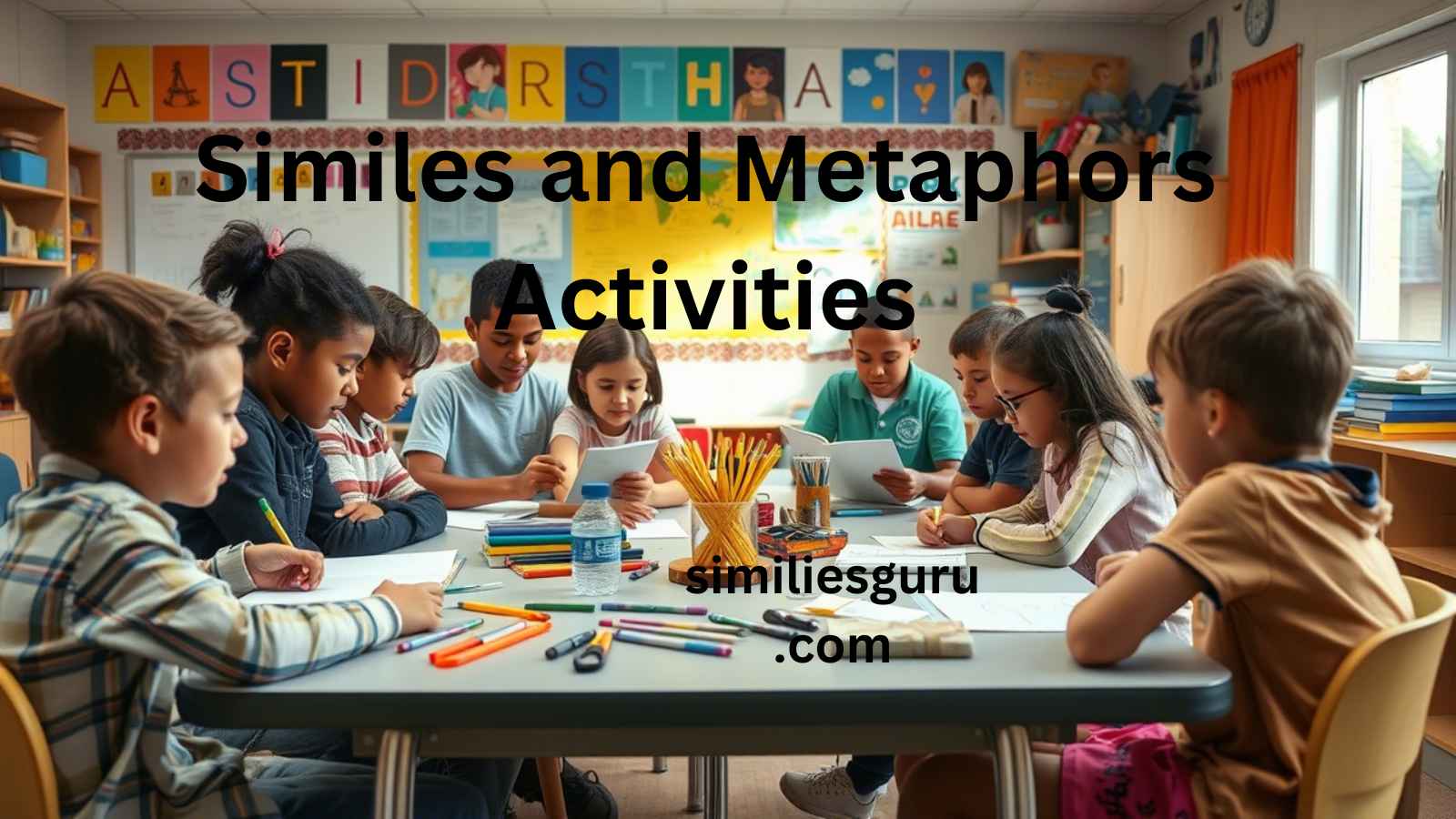Similes and metaphors are not only fun to use but also crucial for enhancing creativity and understanding in language arts. For fourth graders, mastering these figures of speech can foster both their writing and comprehension skills. These two tools—often taught together—help students explore the beauty of language, make connections between different ideas, and elevate their storytelling.
In this article, we will explore 15+ engaging activities designed to teach similes and metaphors to 4th graders. Each activity is designed to be fun, educational, and practical, ensuring that students understand the concepts while applying them in their everyday communication and writing.
Understanding Similes and Metaphors
Before diving into activities, it’s important to clarify what similes and metaphors are and how they differ:
Similes
A simile is a comparison between two things using the word “like” or “as.” It makes descriptions more vivid by drawing connections between two seemingly unrelated things. For example:
- Her smile was as bright as the sun.
- He ran like a cheetah in a race.
Metaphors
A metaphor, on the other hand, directly compares two things without using “like” or “as.” It asserts that one thing is another, thus making a stronger connection. For example:
- Time is a thief.
- The classroom was a zoo.
Both similes and metaphors add richness and depth to writing, making abstract ideas easier to grasp and more relatable.
15+ Activities to Teach Similes and Metaphors to 4th Graders
1. Simile & Metaphor Bingo
Create bingo cards filled with different similes and metaphors. As you read out sentences, students mark the corresponding figure of speech. This game not only reinforces the understanding of similes and metaphors but also helps students identify them in real-world contexts.
2. Simile and Metaphor Match-up
Write a variety of similes and metaphors on separate index cards, and then write the comparisons or objects being compared on another set of cards. Students need to match them correctly. For example, match “as fast as a cheetah” with “speed” or match “the classroom was a zoo” with “chaotic.”
3. Simile and Metaphor Charades
In this activity, students act out various similes and metaphors without speaking, and their classmates try to guess the figure of speech. This helps students understand the underlying meanings of similes and metaphors by physically embodying them.
4. Creative Writing Using Similes
Give students a list of items or emotions (e.g., a rainy day, happiness, an old tree) and ask them to come up with at least five similes for each. This encourages students to think creatively and practice writing similes in their work.
5. Simile and Metaphor Scavenger Hunt
Hide slips of paper with similes and metaphors around the classroom or schoolyard. Students search for the phrases and then explain how they fit the definition of similes or metaphors. This activity is interactive and promotes teamwork and critical thinking.
6. Metaphor & Simile Art
Have students draw pictures or create collages that represent various metaphors and similes. For example, for the metaphor “The classroom was a zoo,” they could draw an image of a classroom with animals. This visual representation reinforces the meaning behind the phrases.
7. Fill-in-the-Blanks Sentences
Create a worksheet with sentences that have missing parts. For example, “The dog was as ______ as a cloud.” Students then fill in the blank with a fitting simile or metaphor, such as “fluffy” or “soft.” This reinforces understanding of how to complete comparisons.
8. Simile and Metaphor Story Creation
Ask students to write short stories or poems that incorporate at least five similes and metaphors. Encourage creativity by having them pick unusual or imaginative comparisons. Sharing these stories with the class can also promote collaborative learning.
9. Simile and Metaphor Sorting
Create a set of cards with different expressions. Some should be similes, and others should be metaphors. Ask students to sort them into two piles and explain why they belong in each category. This helps develop their critical thinking and understanding of figurative language.
10. Simile and Metaphor Tic-Tac-Toe
Set up a tic-tac-toe board and assign a simile or metaphor challenge for each space. For example, “Write a simile about a storm” or “Create a metaphor for joy.” Students take turns completing the challenges to earn their spot on the board.
11. Simile and Metaphor Drama
In pairs, students write short skits that include a variety of similes and metaphors. They perform the skits for the class, and classmates guess the figures of speech used. This activity allows students to practice their language skills while engaging in performance art.
12. Simile and Metaphor Poetry
Encourage students to write a poem using only similes and metaphors. This helps them express themselves creatively while practicing their figurative language skills. They can focus on different themes such as nature, emotions, or friendship.
13. Simile and Metaphor Crossword Puzzle
Design a crossword puzzle where the clues are similes or metaphors, and students must figure out the answers based on the figurative language used. This makes the activity challenging and educational while also being fun.
14. Simile and Metaphor Song Lyrics
Give students a popular song lyric and ask them to identify any similes and metaphors within the song. Then, students can write their own lyrics incorporating their own creative similes and metaphors.
15. Simile and Metaphor Jokes
Have students come up with jokes that use similes or metaphors. For example: “Why was the math book sad? Because it had too many problems!” This allows students to see how similes and metaphors can be used humorously and effectively in casual conversation.
16. Simile and Metaphor Pictionary
In this game, one student draws an object or action represented by a simile or metaphor while the rest of the class guesses what it is. This activity is both fun and educational, reinforcing the meaning of figures of speech.
17. Creating Simile & Metaphor Murals
Students work in groups to create large murals that represent different similes and metaphors. They can paint or draw images that visually convey the figurative meaning behind the phrases, reinforcing comprehension in a collaborative environment.
18. Simile & Metaphor Journals
Have students keep a journal where they write down similes and metaphors they encounter in books, movies, or real life. This personal connection helps them better internalize the concepts.
6 User-Friendly Texting Examples for Similes and Metaphors
- Simile Example:
- “Your joke was as funny as a stand-up comedy show!”
- Tone: Lighthearted, casual
- “Your joke was as funny as a stand-up comedy show!”
- Metaphor Example:
- “His voice is music to my ears.”
- Tone: Romantic, sweet
- “His voice is music to my ears.”
- Simile Example:
- “She’s as quiet as a mouse when she’s working.”
- Tone: Neutral, descriptive
- “She’s as quiet as a mouse when she’s working.”
- Metaphor Example:
- “The night sky is a blanket of stars.”
- Tone: Poetic, descriptive
- “The night sky is a blanket of stars.”
- Simile Example:
- “His thoughts were like a whirlwind, rushing around in his mind.”
- Tone: Descriptive, neutral
- “His thoughts were like a whirlwind, rushing around in his mind.”
- Metaphor Example:
- “The classroom is a circus with all the noise today!”
- Tone: Humorous, playful
- “The classroom is a circus with all the noise today!”
Conclusion
Similes and metaphors are powerful tools that enrich the language and help students express themselves more vividly. By engaging in these fun and creative activities, 4th graders can deepen their understanding of these figures of speech and incorporate them into their writing and daily conversations.



